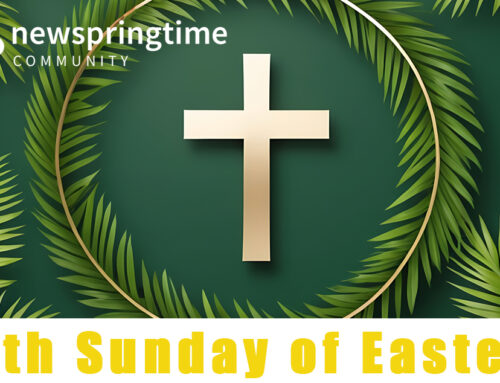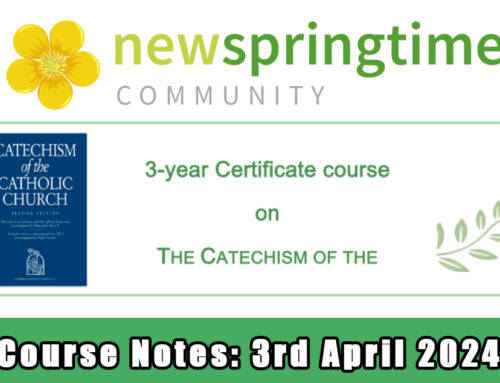The Catechism of the Catholic Church – 7th Feburary 2024
To download The Catechism of the Catholic Church course notes for 7th Feb 2024, please click here
Commentary no 16.
The CCC teaches that during “the Last Supper with his apostles on the eve of his passion Jesus anticipated, that is, both symbolized his free self-offering and made it really present.” It could be argued that Jesus showed the link between the two when he shared with the disciples on the Road to Emmaus. He began by recalling texts from the OT that prophesied his passion and death, and he revealed himself to them, as the risen Lord, when they recognized him in the breaking of bread (Lk 24:13-35).
The passion of Jesus began when he endured an agony in Gethsemane. From a human point of view, the prospect of having to endure the mind-numbing sufferings of passion week was almost too much for Jesus to contemplate. In a way this is surprising.
- Firstly, there was nothing unexpected about what he faced. On a number of occasions Jesus had spoken about his impending passion as an expression of the divine will.
- Secondly, in the wilderness Satan had tempted Jesus to abandon his vocation to be the suffering servant by relying on a miraculous intervention of God if he threw himself off the temple walls. If he did that he would have been able to fulfil his mission in a painless way. Jesus had resisted that temptation.
But in Gethsemane the same temptation seemed to be repeated. Although he was called to be the suffering servant, he seemed to ask his Father to change his plan. In other words, Jesus expressed his anguished hope that the Father might be able to usher in his kingdom without the necessity of redemptive suffering. Having poured out his human feelings in an anguished way, Jesus did, however, remain submissive to God by saying, “Yet not what I will, but what you will.” Although up to that point the Father had often revealed his will inwardly to Jesus, on this occasion there was no apparent communication. Instead, God was silent. His purposes were manifested in and through the unfolding events of the passion. Nevertheless, our Lord courageously embraced God’s saving plan. Afterwards, the author of Hebrews was to observe, “Although he was a son, he learned obedience from what he suffered” (Heb 5:8).
The Jews in the later Old Testament period believed that after death people went to sheol, in Hebrew, or Hades, in Greek. It was the realm of the living dead. It was thought of as a subterranean region clothed in thick darkness, from which it was impossible to return. In the New Testament, Jesus spoke of hell as Gehenna, the place where lost souls suffered punishment (cf. Mt 5:29-30; 10:28). The word was derived from a rubbish dump outside Jerusalem. It was always burning and was associated with a loathsome type of worm. When the creed tells us that Jesus descended into hell, it means that he descended into sheol rather than Gehenna. This phrase can be understood in two interrelated ways. Firstly, when Jesus cried out on the cross: “My God, my God, why have you forsaken me?” (Mt 27:46), he had already begun to enter sheol from a psychological and spiritual point of view. Nailed to the cross he was suspended between heaven and earth, shrouded in darkness, and separated from people and God. When Jesus commended his soul to God, his physical death radicalized his limbo experience. He entered the valley of the dry bones mentioned in Ezech 37:4. Scripture tells us that: “in the spirit he visited the spirits in prison (sheol), and preached to them…so that although their bodies were punished with death, they could still live in their spirits as God lives” (1 Pt 3:18-20; 4:6). Jesus’ descent into sheol, to be with the spirits of the dead, was his ultimate act of abnegation and solidarity. Not only, did he share in their alienation, he also shared the good news about God’s free offer of unconditional mercy and love. They were evangelised by this prophetic message. As a result, they were released from their imprisonment. In Mt 27:52-53 we are told in mythical language: “The tombs broke open and the bodies of many holy people who had died were raised to life. They came out of the tombs, and after Jesus’ resurrection they went into the holy city and appeared to many people” (Cf. Acts 2:24; Eph 4:8-10).
The CCC tells us that the, “sacrifice of Christ, redeems humanity in a way that is unique, and opens up for them communion with God.” Mary was conceived without sin in virtue of the grace her Son would pour out from the Cross. All those who are saved, whether Christians, members of other religions or unbelievers are saved, knowingly or unknowingly by the saving merits of Christ’s death and resurrection.
When we carry a cross of any kind we can ask, like Jesus in Gethsemane, for the favour we desire, e.g., healing of mind or body, but like Jesus we need to say with him, “yet not what I will but what you will.” In the Jesuit Novena of Grace there is a prayer that echoes the words of Jesus, “If what I ask in this prayer is not for the glory of God and for the greater good of my soul, instead obtain for me, I pray, that which would be most conducive to one or the other.”





